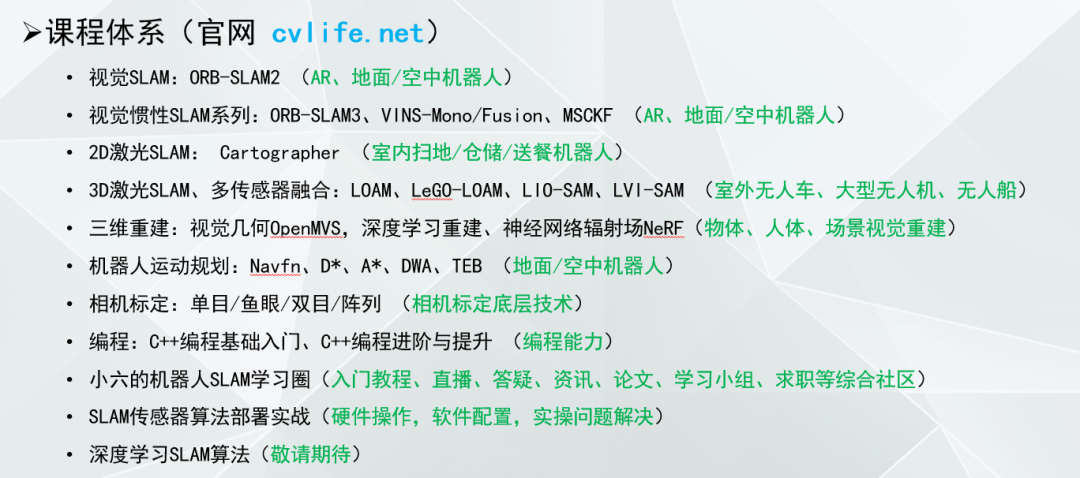SLAM导航中的多传感器融合:算法与实现
发布时间: 2024-07-14 21:37:35 阅读量: 48 订阅数: 21 


# 1. SLAM导航概述**
SLAM(即时定位与地图构建)是一种导航技术,它允许机器人同时构建环境地图并估计其自身位置。SLAM算法利用来自多个传感器的测量值,如激光雷达、摄像头和惯性测量单元(IMU),来实现此目的。
SLAM算法通常分为两类:基于滤波的方法和基于优化的方法。基于滤波的方法,如卡尔曼滤波和粒子滤波,使用贝叶斯滤波框架来估计机器人的状态和地图。基于优化的方法,如图优化和束调整,通过最小化误差函数来估计机器人的状态和地图。
# 2. 多传感器融合算法**
**2.1 卡尔曼滤波**
**2.1.1 基本原理**
卡尔曼滤波是一种递归贝叶斯估计算法,用于估计动态系统的状态。它由以下步骤组成:
1. **预测:**基于当前状态估计和系统动力学模型预测下一状态。
2. **更新:**使用观测值和观测模型更新状态估计。
卡尔曼滤波的优点包括:
* **在线估计:**它可以实时估计状态,无需存储整个状态历史记录。
* **最优估计:**它提供了给定观测值下状态的最小均方误差估计。
* **鲁棒性:**它对测量噪声和系统模型误差具有鲁棒性。
**2.1.2 扩展卡尔曼滤波**
扩展卡尔曼滤波 (EKF) 是卡尔曼滤波的非线性扩展,用于处理非线性系统。它通过线性化非线性系统模型来近似预测和更新步骤。
**代码块:**
```python
import numpy as np
class KalmanFilter:
def __init__(self, A, B, H, Q, R):
self.A = A # 状态转移矩阵
self.B = B # 控制矩阵
self.H = H # 观测矩阵
self.Q = Q # 过程噪声协方差矩阵
self.R = R # 测量噪声协方差矩阵
def predict(self, x, u):
# 预测状态
x = np.dot(self.A, x) + np.dot(self.B, u)
# 预测协方差
P = np.dot(np.dot(self.A, P), self.A.T) + self.Q
return x, P
def update(self, x, P, z):
# 计算卡尔曼增益
K = np.dot(np.dot(P, self.H.T), np.linalg.inv(np.dot(np.dot(self.H, P), self.H.T) + self.R))
# 更新状态
x = x + np.dot(K, (z - np.dot(self.H, x)))
# 更新协方差
P = np.dot((np.eye(len(x)) - np.dot(K, self.H)), P)
return x, P
```
**代码逻辑分析:**
* `predict()` 函数根据状态转移矩阵 `A`、控制矩阵 `B` 和控制输入 `u` 预测状态和协方差。
* `update()` 函数使用卡尔曼增益 `K` 根据观测值 `z` 更新状态和协方差。
**2.2 粒子滤波**
**2.2.1 基本原理**
粒子滤波是一种蒙特卡罗方法,用于估计非线性非高斯系统的状态。它通过一组称为粒子的加权样本近似后验概率分布。
粒子滤波的优点包括:
* **非线性系统:**它可以处理非线性系统,而卡尔曼滤波不能。
* **多峰分布:**它可以近似多峰后验概率分布,而卡尔曼滤波只能近似单峰分布。
* **鲁棒性:**它对异常值和测量噪声具有鲁棒性。
**2.2.2 重要性采样**
重要性采样是粒子滤波中用于从先验分布采样粒子的技术。它通过为更有可能产生观测值的粒子分配更高的权重来改善粒子的分布。
**代码块:**
```python
import numpy as np
class ParticleFilter:
def __init__(self, N, A, B, H, Q, R):
self.N = N # 粒子数量
self.A = A # 状态转移矩阵
self.B = B # 控制矩阵
self.H = H # 观测矩阵
self.Q = Q # 过程噪声协方差矩阵
self.R = R # 测量噪声协方差矩阵
def predict(self, particles, u):
# 预测每个粒子
for i in range(self.N):
particles[i] = np.dot(self.A, particles[i]) + np.dot(self.B, u) + np.random.normal(0, self.Q)
def update(self, particles, z):
# 计算每个粒子的权重
weights = np.zeros(self.N)
for i in range(self.N):
weights[i] = np.exp(-0.5 * np.dot(np.dot((z - np.dot(self.H, particles[i])), self.R), (z - np.dot(self.H, particles[i]))))
# 归一化权重
weights = weights / np.sum(weights)
# 重采样
particles = np.random.choice(particles, self.N, p=weights)
return particles, weights
```
**代码逻辑分析:**
* `predict()` 函数根据状态转移矩阵 `A`、控制矩阵 `B` 和控制输入 `u` 预测每个粒子。
* `update()` 函数根据观测值 `z` 计算每个粒子的权重,并使用重采样技术重新分布粒子。
**2.3 无迹卡尔曼滤波**
**2.3.1 基本原理**
无迹卡尔曼滤波 (UKF) 是卡尔曼滤波的另一种非线性扩展,它通过使用无迹变换来避免 EKF 中的线性化步骤。
UKF 的优点包括:
* **非线性系统:**它可以处理非线性系统,而卡尔曼滤波不能。
* **准确性:**它比 EKF 更准确,因为它不需要线性化非线性系统模型。
* **计算效率:**它比粒子滤波更有效,因为它不需要大量的粒子。
**2.3.2 性能分析**
UKF 在以下方面优于 EKF:
* **准确性:**UKF 在非线性系统中提供了更高的估计精度。
* **鲁棒性:**UKF 对系统模型误差和测量噪声更具鲁棒性。
* **计算效率:**UKF 的计算成本比 EKF 低。
UKF 在以下方面优于粒子滤波:
* **准确性:**UKF 在非线性系统中提供了更高的估计精度。
* **计算效率:**UKF 比粒子滤波更有效,因为它不需要大量的粒子。
* **鲁棒性:**UKF 对异常值和测量噪声更具鲁棒性。
# 3.1 激光雷达和IMU融合
#### 3.1.1 传感器模型
**激光雷达模型**
激光雷达传感器通过发射激光束并测量其反射时间来获取环境深度信息。其测量模型可以表示为:
```
z_l = h_l(x) + v_l
```
其中:
* `z_l` 是激光雷达测量值,表示激光束到障碍物的距离
* `h_l(x)` 是激光雷达测量模型,将机器人状态 `x` 映射到激光雷达测量值
* `v_l` 是激光雷达测量噪声,服从正态分布
**IMU模型**
IMU(惯性测量单元)传感器通过测量加速度和角速度来估计机器人的运动。其测量模型可以表示为:
```
z_i = h_i(x) + v_i
```
0
0





